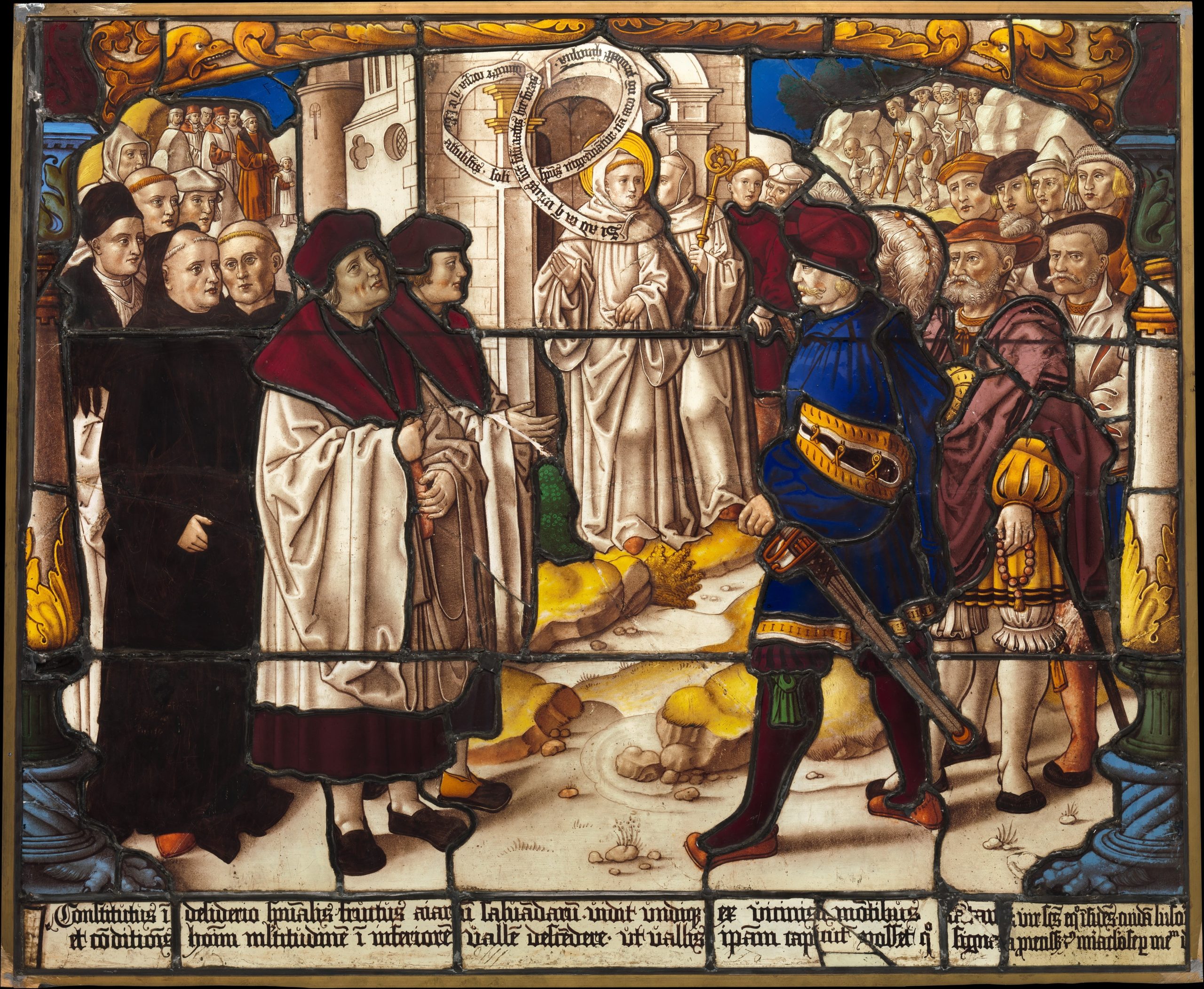
ABOUT THE ART
Master of Saint Severin. “Life of Saint Bernard of Clairvaux: Saint Bernard exhorts the sick in body to enter his church with their spirits, in doing so returning to find their infirmities healed (one of two).” After 1535. Stained glass. Overall (confirmed, irregular width): 28 1/16 x 34 7/16 in. (lower edge) or 33 3/4 in. (upper edge). (71.3 x 87.5 or 85.7 cm); Other (thickness of brass framing): 3/8 in. (1 cm). German, Cologne. The Metropolitan Museum of Art, New York. Accession Number 59.183.2.
This is one of six scenes from a set of twenty-two windows that depict the Life of Saint Bernard. These windows were created for the glazed cloister at Altenberg, located near Cologne.
The scene depicts Saint Bernard with Clergy and Scholars, in which the abbot invites a multitude of people to enter his church in spirit, leaving their physical bodies behind. Through faith, their spirits are miraculously healed, and their infirm bodies mended.
In the painting, the clergy stands in front of the church, while Saint Bernard is situated in the portal with an inscribed scroll above and to the left of his head. An attendant stands behind him, holding a pastoral staff. To the left of Saint Bernard, two patricians are followed by two monks in brown robes and four other figures. On the right, three nobles are depicted, with the first dressed in blue and the second in red and yellow. They are accompanied by six attendants. The background and the church are painted in white and beige, and the entire scene is set within a foliate arch on columns.
Saint Bernard of Clairvaux – August 20th
Bernard is one of the great teachers in Christian history (designated a Doctor of the Church). He was an eloquent preacher and writer and spent much of his days combating heresies. Even the Protestant Reformers like Martin Luther quoted him on the importance of salvation by faith.
It should be mentioned that Bernard’s legacy is tarnished by his involvement in encouraging the Crusades. Yet, he is most celebrated for his way with words. He is credited with writing great hymns like “O Sacred Head Now Wounded” and “Jesus, the Very Thought of Thee.”
We are celebrating him with a French feast of Dijon Chicken.
Dijon Chicken
Keep the screen of your device on
Ingredients
2 2 boneless skin-on chicken breasts (6 to 8 ounces each)
Salt and black pepper
1 tablespoon 1 canola oil
3/4 cup 3/4 low-sodium chicken stock
1 1/2 teaspoons 1 1/2 powdered gelatin
1 small 1 shallot, minced (about 1 tablespoon)
1/4 cup 1/4 bourbon
2 tablespoons 2 whole grain mustard
2 tablespoons 2 unsalted butter
2 teaspoons 2 soy sauce
1 teaspoon 1 fresh juice from 1 lemon
1 tablespoon 1 minced fresh parsley leaves
Directions
- Adjust oven rack to center position and preheat oven to 450°F. Pat chicken breasts dry and season generously with salt and pepper.
- Heat oil in an oven-safe medium skillet over high heat until just starting to smoke. Carefully lay chicken breasts into hot skillet skin side down. Cook without moving until skin is deep golden brown and very crisp, about 6 minutes. Carefully flip chicken breasts and transfer skillet to the oven.
- While chicken roasts, add stock to a liquid measuring cup and sprinkle gelatin over the top. Set aside.
- Cook chicken until an instant-read thermometer inserted into the thickest part of the chicken breasts registers 150°F, about 7 to 12 minutes. Remove skillet from oven and transfer chicken to a cutting board. Set aside to rest while you make the pan sauce.
- Pour off all but 1 tablespoon of fat from the skillet and place over high heat. Add shallots and cook, stirring, until softened and fragrant, about 30 seconds. Add bourbon and cook scraping up any browned bits from the bottom of the pan with a wooden spoon, until reduced by half, about 1 minute. Add the mustard and the stock/gelatin mixture and cook on high heat until sauce is reduced by about two-thirds, 5 to 8 minutes. Stir in butter, soy sauce, and lemon juice and cook at a hard boil about 30 seconds. Remove from heat and set aside.